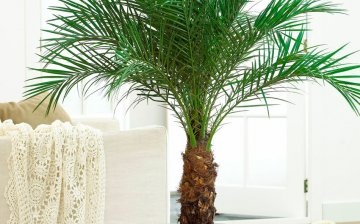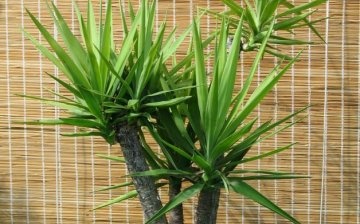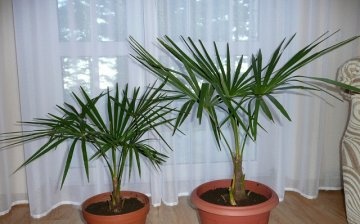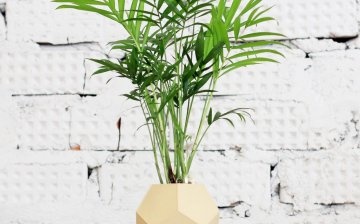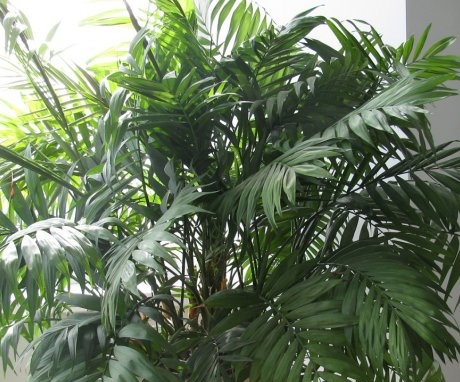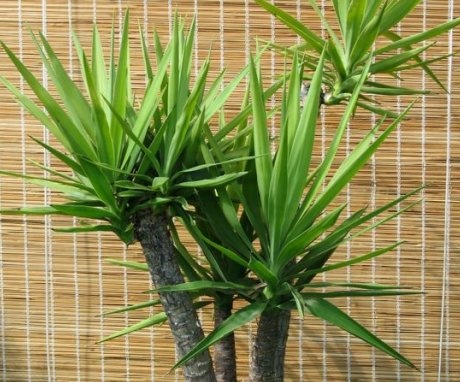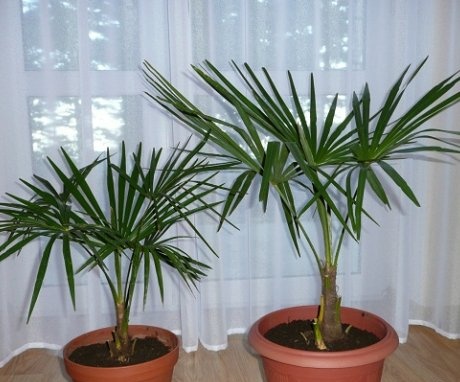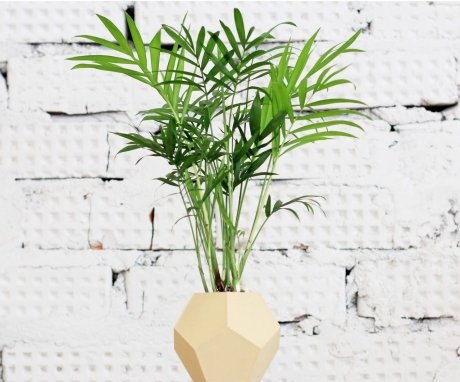Indoor palm: the most popular types
Among the green inhabitants of houses and apartments, palm trees took the lead long ago, when they were given a place of honor in the palaces of nobles and kings. The majesty of tropical plants, the diversity of their species are striking.
The variety of indoor palm species favors the cultivation of both single-stemmed and bushy plant types. Tropical culture is appreciated for the beauty of the cut of the leaves, their interesting arrangement on the petioles, trunk. Of course, slender and majestic beauties are suitable for spacious rooms in which you can create a green corner of the tropics.
Content:
- Varieties of indoor palm, their description
- Conditions for growing an ornamental plant
- Features of caring for a room palm
- Disease prevention, pest control
Varieties of indoor palm, their description
About three thousand varieties of indoor palm are cultivated in the world. They compete with each other not only in the height of the trunk, the shape of it and the leaves, but also in terms of growing conditions:
- A native of Australia, Hovea has a straight trunk around which leaf scars are wrapped. Long feathery leaves, frond, sometimes reach four meters in length. Among the varieties of Hovei-Belmore with short red-toned petioles, vertically arranged, Forster with luxurious spreading leaves on a single trunk.
- Hamedoreyu belong to the bushy representatives of palms. One rhizome gives off many trunks with five or six beautifully curved leaves. During flowering, the plant is covered with panicles of orange, red inflorescences. There are known varieties of Hamedorea with golden fronds, dark green curved, crescent-shaped or similar to a narrow lancet.
- It attracts flower growers with the beauty of the fan leaves of Liviston, or Latania. The plant grows slowly, but under good conditions, its gray trunk can reach ten to fifteen meters in height. Light green fans of thin, pointed at the ends of the leaves look beautiful on it.
- The decorative date palm is prized for its lush crown of feathery leaves. This species takes root well, grows well with minimal maintenance. In the period of full maturity after flowering, dark-colored fruits can form on the stems.
- The dwarf species includes the Rapis palm, native to China. Its thin, rigid fronds are cut into seven parts. The unpretentiousness and decorativeness of the plant makes it possible to breed it even in small rooms.
- At Trachikarpus, thin leaves, deeply dissected, spread like a fan on a thin trunk covered with coarse petioles. Above, the leaf blade shines brightly, below it is covered with a bluish bloom. The plant pleases with yellow fragrant flowers, collected in large axillary inflorescences.
- The bright sun prefers Yucca, to other conditions it is less demanding. The broad feathers of its leaves are smooth and juicy.
- Loves well-lit places in the house the Fishtail palm, or Cariota soft. The species is famous for its double-feathery leaves and rapid growth with a minimum of soil. When purchasing this type of palm, you need to know that it needs large areas of premises.
It is impossible to describe all the varieties of indoor palm.But when choosing a certain type of plant for your home, you need to calculate the area that he will need for a comfortable existence, create conditions close to the tropics, subtropics.
Conditions for growing an ornamental plant
You can bring a palm tree to an adult by observing the general growing requirements for all varieties:
- The main property of the soil mixture in which the palm tree will grow is good air and water permeability. As transplant a tropical tree is rarely produced, then the substrate is carefully selected. After all, the plant will stay in it for a long time. There are special mixtures for planting palm trees, consisting of leafy earth, humus with a small addition of sand. The top layer of the earth can be changed annually, adding new, heavier soil.
- The decorativeness of the plant depends on the humidity in the room. The moisture level should be high. You can increase it by placing trays of water next to a growing palm tree, arranging a shower for the tree on hot summer days. Water for spraying is taken from rain or settled. The procedure cannot be carried out on cloudy rainy days, in autumn, in spring. A shower for a plant in the shade is also not needed.
- During the growing season, palms need an air temperature of at least fifteen and not higher than twenty-two degrees Celsius. In winter, it can drop for some species to seven degrees above zero. But excessively hot rooms will dry out the roots of the palm tree, so you do not need to put indoor flowers close to heaters, air conditioners.
- Palm trees need sufficient illumination of the premises of the house, but without excessive brightness of the sun's rays. Therefore, on hot summer days, it is necessary to shade the pots with the plant with a light-colored fabric. Indoor crops can be taken out into the open air, but they are afraid of drafts.
Each type of ornamental plant has its own growing conditions.
Features of caring for a room palm
Care Tips:
- Watering houseplants are carried out regularly with soft water to prevent leaching of the soil in the pot. Excessive moisture accumulating in the container leads to root rot. Before watering a palm tree, you need to check the condition of the soil. And it is worth moistening when the top layer of the earth has become dry.
- The lack of trace elements is reflected on the leaves with yellow, brown spots, slowing palm growth, foliage falling. They will save the fertilizing bush with liquid fertilizer Agricola when diluting one tablespoon of the drug in ten liters of water. Fertilizers are applied in the summer once every ten days, during the rest period - every twenty days. Be sure to loosen the soil after watering with the nutrient mixture. An oversupply of fertilizer will result in a problem with root and stem growth.
- It is better to transplant an indoor beauty rarely, when you really can't do without it. For the procedure, choose a larger pot. Having carefully broken the old container, the palm tree, along with a lump of earth on the roots, is placed in a new flowerpot, adding soil there. At the same time, touch the roots, you cannot cut them. The palm tree does not tolerate a transplant, therefore, frequent watering is necessary to remove the flower from stress.
- Beautiful leaves, frond, require careful removal of dust with a soft cloth. Sometimes they are washed with warm water. Do not add chemicals to the washing solution, as this will lead to yellowing of parts of the plant.
Representatives of palm trees are not too picky about care and require little attention.
Disease prevention, pest control
Usually, improper care provokes the appearance of problems in the growth and development of the palm tree. If yours turn brown or yellow, the point is improper watering - there is a lack or excess of moisture. Low air humidity provokes the appearance of dry areas of the plate with a brown tint on the tips of the leaves.
The appearance of fungal diseases often occurs at high air temperatures and high humidity in the room.
Diseases are expressed in the appearance of oval-shaped spots, a border of brown, gray, white on the leaves. Due to the spread of fungal spores, the size of the spots increases. To save the palm, the damaged parts are removed, the number of watering is reduced, the air temperature in the room is lowered. If the cause of the disease is infected soil, then the palm tree is transplanted. Spraying the bush is also mandatory. fungicidal preparations.
When infected with root rot, the plant slows down in development, turns yellow, some areas die off on the rhizomes. Necrotic zones should be removed from the palm tree, its rhizomes should be placed in a solution of a preparation like Homecin. After holding fifteen minutes in the drug, sprinkle the wounds with a crushed tablet of activated carbon. Then a new pot is chosen for the palm tree.
Pests of indoor palms:
- Of the pests, the spider mite most often attacks the flower, actively feeding on its juices. Damaged green parts are covered with a white coating. You can spray a tropical tree with Vertimek or a decoction of cyclamen to completely destroy the parasite.
- White mealybugs, multiplying, climb into the veins, petioles, roots, ovaries of young leaves. The palm tree begins to wither, turn pale, loses its healthy appearance. The pest can be destroyed with the help of special preparations such as Actellic
- It is especially difficult to fight thrips - they can wait a long time on windowsills, pots. Therefore, when treating an infected plant with insecticides such as Fitoverm, it is necessary to wipe the parts of the window, the container where the indoor flower is located.
Mistakes in the care of a room palm are the cause of its malaise, even death.
More information can be found in the video:



